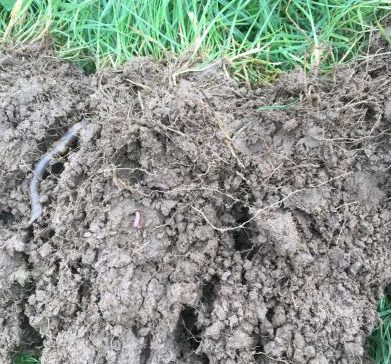Looking back at 2023, it can safely be defined as a challenging year with the wettest autumn / winter we have seen for decades. Farmers have not only faced the challenge of maximising yields and optimising soil health, but also battling against the elements to drill crops into the ground. Hoping for a kinder 2024, this blog explores options to build resilience into crop rotations aiming to cultivate a balance between high yields and optimum soil health.
Minimising cultivation
First things first, this blog is not telling you to get rid of the plough. All machinery serves a purpose, it is just about knowing when to intervene. Within systems that have reduced their cultivations or those that have been adopting conservation ploughing (i.e. ploughing one year in three or more), soils tend to be more resilient through improved soil structure. Good soil structure has a matrix of small, medium, and large pore spaces able to retain and drain water as well as provide pockets of air for respiration and gaseous exchange and water for nutrient exchange. When we till the soil, especially when ground conditions are sub-optimum, we run the risk of squashing the pores and causing compaction and soil degradation, reducing water infiltration, increasing anaerobism (lack of oxygen) and building up toxic gases, all contributing to poor soil health and disappointing crop yields.


Carry out a VESS: Visual Evaluation of Soil Structure
It is important to get out there and dig holes; get to know your soil and how it behaves under certain environmental conditions. When you assess the soil structure, look for compaction and note its depth. Can this be remedied by deeper rooting species, or does it require mechanical intervention? Always keep the depth in mind as it’s no good going in too deep or too shallow.
Diversity
Sustainable rotations begin with diversity. A multipronged approach combining arable crops, legumes and cover crops takes full advantage of all the tools we have in the box as arable farmers. Diversity in species above ground matches diversity in species below ground: helping to break pest and disease cycles and improve soil health through provision of various rooting architecture, root exudates and crop residues. The soil is alive and many of the nutrients available to crops and plants come from the activity of soil-dwelling organisms that are busy stabilising, consuming and releasing nutrients for the benefit of the crop. Diversity in crops and roots therefore contribute a rich source of food for soil fauna to feast on, enhancing soil fertility and subsequent crop health and crop yield.
Where pests and disease more commonly thrive is within monocultures e.g. continuous cereals. We are seeing an increasing reliance on chemicals to control and abate problems within these systems, depleting our soils of beneficials in the process. Similarly, a lack of diversity in roots are only supporting a limited community of microorganisms. This is not sustainable; therefore, we must explore how we can incorporate more species within the rotation. OSR is one of many good examples. It has deep roots and is easily diversified with companions e.g. vetch / buckwheat / berseem clover. Maximising the number of crop species in a rotation will optimise the diversity of organisms below ground.
On farm, an easy way to measure how biologically active our soils are is by monitoring earthworm numbers. Earthworms are at the top of the soil food web and will travel to and reside where there is lots of food; they are also brilliant at breaking down residues and redistributing nutrients throughout the soil profile. How many worms do you count in a spade full of soil? Where are you finding the most? And can those numbers be replicated elsewhere on farm?
Legumes
The blog wouldn’t be complete without talking about legumes. Approximately 78% of the air is nitrogen. If we can harness the power of leguminous plants to fix some of that nitrogen, we can cut costs by reducing the amount of artificial fertiliser whilst also minimising our environmental impact. Consider incorporating peas or beans into the rotation as stand-alone crops, clover as a companion crop or include legumes as part of a cover crop mix. Farmers are often able to reduce the amount of bagged fertiliser used after legumes.

Legumes to build fertility: field beans in an arable rotation
If possible, trial a small reduction across a proportion of the field first and see how your yields fare – you might be pleasantly surprised.
Cover Crops
Utilising cover crops between winter and spring cropping is an excellent approach to building soil health in between cash crops: stabilising soil structure by maintaining living roots in the soil throughout the year, feeding the soil biology and acting as a buffer protecting the soil from adverse weather conditions.
On top of this, one of the biggest advantages of cover crops is that they are great at scavenging and holding onto residual nutrients left over from the previous crop, reducing losses from leaching. Once destroyed, the nutrients will be released back into the soil, improving nutrient use efficiency, and potentially enabling a reduction in artificial inputs required by the next crop.
Cover crop mixes should be tailored to your needs and soil type. It’s better to choose species type based on what you are trying to achieve: building fertility, keeping the ground covered, and/or alleviating compaction.
If possible, conduct trials and aim to include 3 or more species in the mix to capitalise on diversity in both the above-ground biomass for optimised photosynthetic potential (think assortment of leaf shapes to increase surface area from which to harness the sun’s energy), and below-ground biomass through varied rooting structures, depths, shapes and sizes (pumping sugars and carbon into the soil, building soil organic matter and feeding the soil biology).
Livestock Integration
Integrating grazing livestock into your rotation offers an alternative technique to destroying cover crops whilst also adding valuable organic matter to the soil in the form of manure. Including grass and clover leys also gives the ground a break, allowing time for recovery and offers another income stream from grazing or silage / hay making. The benefits of perennial roots in the ground over an extended period, especially if a mix of roots at different depths, will help to improve soil structure and build fertility for future crops.

Grazing livestock returning soil organic matter and building soil health.
Explore the Sustainable Farming Incentive options to see if herbal leys or a 2-year legume fallow could be economically viable.
Monitoring and Adapting
It is important to remember that there is no one-size-fits-all approach; be adaptive and tailor options to local environment and conditions. Trial different methods and see which suits your system best.
Regularly monitoring soil health, accounting for all nutrient sources, and keeping an eye on pest and disease prevalence alongside crop performance and weather is crucial to make informed adjustments to rotations as needed.
In summary, farmers are in a unique position in that yes, we produce emissions in the process of producing nutritious food however, we can also build soil health and boost biodiversity simultaneously contributing to offsetting our own emissions and future proofing our farms and landscapes. Implementing a sustainable crop rotation in the UK is not just about growing crops; it’s about promoting a future where productivity and soil health co-exist. By diversifying crops, integrating legumes, embracing cover crops, minimising tillage, incorporating livestock, and tailoring practices to local conditions, it is possible to achieve a resilient and sustainable agricultural landscape supporting local and wider communities for years to come.

